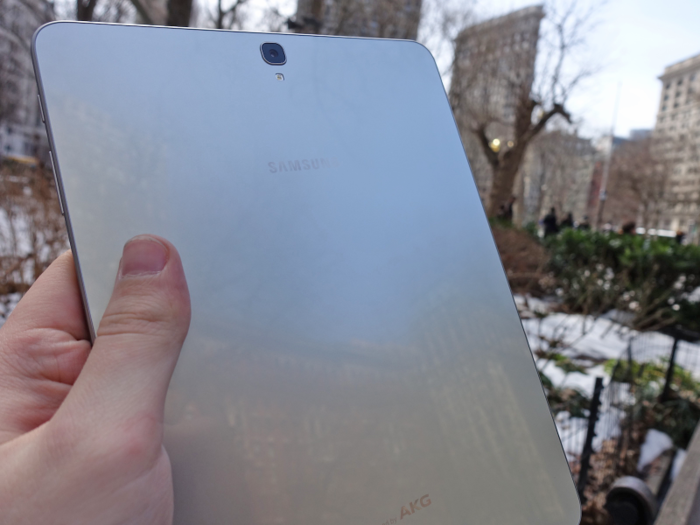- Home
- smallbusiness
- Tech
- I tried Samsung's Android answer to the iPad Pro - here's what it's like
I tried Samsung's Android answer to the iPad Pro - here's what it's like
I tried Samsung's Android answer to the iPad Pro - here's what it's like

I tried Samsung's Android answer to the iPad Pro - here's what it's like

The Galaxy Tab S3 isn’t flawless — the bezels around its display should be thinner, the touted HDR display tech isn’t great (and doesn’t have much content to work with anyways), and, again, glass backs are slippery. But if you wanted a high-end Android tablet, it is a very pleasant way to watch videos and browse the web while you’re laying around.
The question is, what place is there for a high-end Android tablet in the first place? The Galaxy Tab S3 is a straight shot at Apple’s 9.7-inch iPad Pro, with the same $599 starting price. Like the iPad Pro, it wants to justify its high margins by saying it can help you be productive. Samsung sells the keyboard case and pre-loads a bunch of work-centric apps to help with that.
I tried Samsung's Android answer to the iPad Pro - here's what it's like

Now, how strong this pitch is depends on what “laptop” means to you. If you just want a thing to do some light word processing, check Facebook, and play a game or two, the Galaxy Tab S3 is quick enough, and way easier to carry around than a traditional PC. This is a well-worn discussion, but suffice to say that a nice, fast tablet like this meets a lot of needs for a growing number people who only value “regular” laptops because their screens are bigger.
But for those who need more, the Galaxy Tab S3 can’t really replace a laptop, just like the iPad Pro couldn’t before it. For example: On any given weekday afternoon, I have 20 tabs open across three Chrome windows, with Photoshop, Spark, and iMessage going in the background.
Can you recreate this sort of environment on a tablet? Sure. But it’s slower, not just because it uses a mobile chip, but because it’s filtered through a mobile OS. Going back and forth between tapping on a screen and typing on a keyboard is awkward, and you’re always stuck with two windows open at a time. The process of changing apps in that split-screen view can feel convoluted, and some don’t work with it at all.
The Galaxy Tab S3 doesn’t make this feel any more natural. The fact that its keyboard feels cramped, lacks any sort of backlighting, and only sits at one angle doesn’t help. (That it doesn’t require charging is a plus, at least.)
I tried Samsung's Android answer to the iPad Pro - here's what it's like

The bigger problem is that even if everything did click, Android still lags behind iOS on large screens. It’s getting better, to be clear, but the Google’s Play Store still has a handful of notable apps that are explicitly listed as “Designed for phones.” You're just more likely to find an app that doesn’t make use of the real estate here than with the iPad.
Even when apps are technically “tablet-optimized,” things like Google Docs are too stripped-down to be as useful as they are on the desktop. And if you play games, Android will get the bigger ones, but usually plays second fiddle in terms of updates and releases.
Samsung’s spin on Android 7.0 here does include a few useful things for work, such as a file manager and a secure folder for stashing away sensitive items. But it makes noticeable changes to the look of the software, per usual, and includes a few not-entirely-necessary apps by default. Because of that, you’ll likely have to deal with delays in getting the latest version of Android onto the device. This is not a problem with the iPad.
I tried Samsung's Android answer to the iPad Pro - here's what it's like

The Samsung Galaxy Tab S3 is one of the two best pure Android tablets (the other is Pixel C). If you’ve got $600 to burn, want an excellent display for reading and video viewing, and are just beholden to Android, by all means go for it. That OLED screen is a real selling point next to the the iPad Pro. Pairing it with a stylus and keyboard is slightly cheaper, too.
But it’s not like the iPad’s display is shoddy, and iOS still feels more at ease than Android in a tablet environment. That, plus the non-glass back, keeps it as the high-end tablet to beat. And if you're one of the many people who don’t stress their tablet heavily, the aforementioned Nvidia Shield is plenty competent for $400 less.
Beyond that, the Galaxy Tab S3 hasn't proven you can slap a keyboard on a high-end tablet and use it like a laptop, or pushed the debate around that issue forward. A Windows machine like the Surface Pro (or, possibly, Samsung’s own Galaxy Book) is still your best bet for a laptop replacement, though even those are still awkward (and expensive). If Google can bring Android in harmony with Chrome OS, though, something like the Galaxy Tab S3 may make more sense.
Popular Right Now
Advertisement